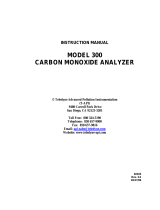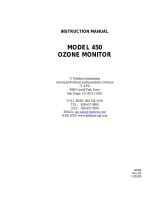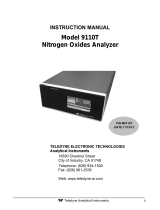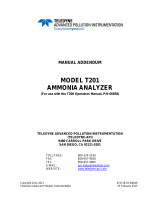Page is loading ...

MANUAL ADDENDUM
MODEL M201E
AMMONIA ANALYZER
(For use with the M200E Operators Manual, P/N 04410)
TELEDYNE ADVANCED POLLUTION INSTRUMENTATION
(TELEDYNE-API)
9480 CARROLL PARK DRIVE
SAN DIEGO, CA 92121-5201
TOLL-FREE: 800-324-5190
FAX: 858-657-9816
TEL: 858-657-9800
E-MAIL: [email protected]
WEB SITE: www.teledyne-api.com
Copyright 2006-2012 05206H DCN5910
Teledyne Advanced Pollution Instrumentation
07 May 2012


05206H DCN5910 i
ABOUT THIS MANUAL
This manual is an addendum that supplements the M200E NOx Analyzer manual, p/n 04410; it
includes document(s) as listed below.
Part No. Name/Description
06185H
M201E Spare Parts List (in Section 6.0)
Note: Please refer to our Website or Sales for more
recent updates.
NOTE
We recommend that this manual and the M200E manual be read in their
entirety before any attempt is made to operate the instrument.
REVISION HISTORY
M201E, MANUAL ADDENDUM, PN 05206
Date
To Rev DCN Change Summary
07 May 2012 H 5910 Updated specs and valve port labels
14 May 2010 G 5731 Administrative additions
17 Nov 2009 F 5588
Added thermocouple replacement
instructions
Updated catalytic cartridge illustration
Updated pneumatic diagrams
Updated Spare Parts List Rev E to F

ii 05206H DCN5910
This page intentionally left blank.

Teledyne API Model M201E NH
3
Analyzer Operator Manual M201E Ammonia Analyzer
05206H DCN5910 iii
SAFETY MESSAGES
Your safety and the safety of others is very important. We have provided many safety messages
throughout this manual; please read these messages carefully.
A safety message alerts you to potential hazards that could hurt you or others. Safety messages
are associated with a safety alert symbol. These symbols are found in both the M200E and
M201E manuals and are also located inside the instrument. The definition of these symbols is
described below:
GENERAL WARNING/CAUTION: Refer to the instructions for details on the
specific danger.
CAUTION: Hot Surface Warning
WARNING: Electrical Shock Hazard
Technician Symbol: All operations marked with this symbol are to be performed
by qualified maintenance personnel only.
Electrical Ground: This symbol inside the instrument marks the central safety
grounding point for the instrument.
CAUTION The analyzer should only be used for the purpose
and in the manner described in this manual.
If you use the analyzer in a manner other than that for which
it was intended, unpredictable behavior could ensue with
possible hazardous consequences.

iv 05206H DCN5910
This page intentionally left blank.

05206H DCN5910 v
TABLE OF CONTENTS
1.0 M201E AMMONIA ANALYZER .............................................................7
1.1 Theory of Operation...................................................................................................... 10
1.1.1 Minim
izing PMT Drift.......................................................................................... 11
1.1.2 Purging the Reaction Cell..................................................................................... 12
1.2
Special Considerations For Ammonia Measurement ................................................... 12
1.3 Sa
mple Filtration........................................................................................................... 13
1.4 M201E Analyzer Specifications................................................................................... 14
2.0 CALIBRATION PROCEDURE .............................................................15
2.1 Zeroing The Analyzer................................................................................................... 16
2.2 Spanning The Analyzer With Nitric Oxide Gas........................................................... 17
2.3 Spanning The Analyzer With Ammonia Gas ............................................................... 20
3.0 CONFIGURABLE ANALOG OUTPUT OVERVIEW ...........................25
3.1 Analog Output - Electronic Configuration ................................................................... 27
3.2 Analog Output Signal Type and Range Selection ........................................................ 28
3.3 Selecting Auto Or Manual Analog Output Calibration ................................................ 29
3.4 Manually Calibrating Analog Output Signal Levels .................................................... 32
3.5 Analog Output Recorder Offset Adjustment ................................................................ 34
4.0 MAINTENANCE SCHEDULE...............................................................35
4.1 M501 NH
3
, Maintenance ............................................................................................. 35
4.2 Replacing the Catalytic Cartridge................................................................................. 36
4.3 Replacing the Thermocouple........................................................................................ 37
4.4 AutoZero Flow Check................................................................................................... 39
5.0 ALARMS AND CAUTIONS ..................................................................41
5.1 Alarm ............................................................................................................................ 41
5.2 Caution.......................................................................................................................... 41
6.0 M201E SPARE PARTS LIST ...............................................................43
7.0 CALCULATING MOLY CONVERTER EFFICIENCIES ......................47
7.1 Purpose:......................................................................................................................... 47
7.2 TOOLS:......................................................................................................................... 47
7.3 PARTS:......................................................................................................................... 47
7.4 PROCEDURE............................................................................................................... 47
LIST OF FIGURES
Figure 1-1. M201E Pneumatic Connection Diagram with External Calibrator Option (ECO)...... 8
Figure 1-2. M201E and M501 NH
3
, Pneumatic Flow.................................................................... 9
Figure 1-3. M201E and M501 NH
3
, with Zero and Span Valve Options Pneumatic Flow.......... 10
Figure 3-1. Analog Output Connector.......................................................................................... 25
Figure 3-2. Analog Output Signal T
ype ....................................................................................... 28
Figure 3-3. Auto Or Manual Analog Output Calibration ............................................................. 30
Figure 3-4. Analog Output Group Calibration
.............................................................................. 31
Figure 3-5. Setup For Calibrating Analog Output Signal Levels
................................................. 32

vi 05206H DCN5910
Figure 3-6. Analog Output Manual Calibration............................................................................ 33
Figure 3-7. Analog Output Recorder Offset Calibration.............................................................. 34
Figure 4-1. Catalytic Cartridge..................................................................................................... 36
Figure 4-2. Thermocouple Location............................................................................................. 37
Figure 5-1. M201E Functional Block Diagram
............................................................................ 42
LIST OF TABLES
Table 1-1. M201E Operating Specifications ................................................................................ 14
Table 2-1. Zero Calibration Procedure – Zero Gas Through the SAMPLE Port ......................... 16
Table 2-2. Zero Calibration Procedure - Zero Gas Through ZERO Port ..................................... 17
Table 2-3. NO Calibration Procedure – NO Gas Through the SAMPLE Port............................. 18
Table 2-4. NO Calibration Procedure - NO Gas through the SPAN Port.................................... 19
Table 2-5. Confirming Ammonia Converter Efficiency............................................................... 21
Table 2-6. NH3 Calibration Procedure – NH3 Gas Through The SAMPLE Port........................ 22
Table 2-7. NH3 Calibration Procedure – NH3 Gas through the SPAN Port................................ 23
Table 3-1. Analog Output Data Default Settings.......................................................................... 25
Table 3-2. Analog Output Pin-Outs.............................................................................................. 26
Table 3-3. Analog Output Voltage Range Min/Max.................................................................... 27
Table 3-4. Analog Output Current Loop Min/Max ...................................................................... 27
Table 3-5. ZERO/SPAN Analog Output Signal Calibration Tolerances...................................... 32
Table 4-1. Preventative Maintenance Schedule............................................................................ 35
Table 4-2. M501 NH
3
, Converter Rebuild Parts List.................................................................... 36
Table 4-3. Analyzer Flow Check.................................................................................................. 39

05206H DCN5910 7
1.0 M201E AMMONIA ANALYZER
This manual is to be used in conjunction with the M200E NO
x
Analyzer
manual, p/n 04410 supplied with this instrument. It is important that you
familiarize yourself with the workings of the NO
x
analyzer before proceeding
with NH
3
measurements.
The M201E ammonia analyzer consists of a modified M200E nitrogen oxide
analyzer and an M501 NH
3
, ammonia converter. The analyzer measures the
following individual gas concentrations: TNx (NH
3
and NO
x
),
NO
x
(NO and NO
2
)
and NO in the sample gas.
The
ammonia concentration is calculated by subtracting the NO
X
reading from the TNx measurement.
The
nitrogen dioxide concentration is calculated by subtracting the NO
reading from the NO
x
measurement.
The instrument is available in three pneumatic configurations:
The M201E with External Calibrator Option (ECO) is shown in Figure
1-1.
The basic system is shown in Figure 1-2.
The M201E with Zero/Span valves is shown in Figure 1-3.
Note: For an M201E analyzer with Zero/Span option you must connect the
umbilical cord P/N 02255 between the analyzer and the external M501 NH
3
,
converter assembly.
If the analyzer is purchased without the Zero/Span option then the zero and span
calibration gases must be individually applied to the sample port. Remember, the
gases must be clean/dry and supplied at ambient pressure.
CAUTION
Do not pressurize the Sample/Span/Zero port above ambient

M201E Ammonia Analyzer Teledyne API Model M201E NH
3
Analyzer Operator Manual
8 05206H DCN5910
Figure 1-1. M201E Pneumatic Connection Diagram with External Calibrator Option (ECO)

Teledyne API Model M201E NH
3
Analyzer Operator Manual M201E Ammonia Analyzer
05206H DCN5910 9
Figure 1-2. M201E and M501 NH
3
, Pneumatic Flow

M201E Ammonia Analyzer Teledyne API Model M201E NH
3
Analyzer Operator Manual
10 05206H DCN5910
Figure 1-3. M201E and M501 NH
3
, with Zero and Span Valve Options Pneumatic Flow
1.1 THEORY OF OPERATION
The Teledyne-API Model M201E analyzer measures ammonia by oxidizing
it to
nitric oxide by the following reaction:
4NH
3
+ 5O
2
4NO + 6H
2
O
The resulting nitric oxide is then measured by the chemiluminescent reaction with
ozone. Consult Section 10.1 in the M200E manual (provided with this
instrument) for more details on the nitric oxide measurement.
The analyzer uses two converters to oxidize the different sample gases. A high
temperature catalytic converter, the M501 NH
3
,, converts NH
3
and NOx into NO
creating the TN
x
channel. A second converter, housed inside the M201E
analyzer and consisting of heated molybdenum, converts all of the NO
x
in the
sample to NO producing the NO
x
channel. The nitric oxide channel is measured
while bypassing both the M501 NH
3
, and molybdenum converter. A Nafion® drier
operated in reflux mode, is installed prior to the molybdenum converter and the
AutoZero valve. The drier removes ammonia and water from the switched
stream. The ammonia would have otherwise been converted by the molybdenum

Teledyne API Model M201E NH
3
Analyzer Operator Manual M201E Ammonia Analyzer
05206H DCN5910 11
and registered as NO
x
. This location provides the drier with continuous flow,
thereby allowing it to stabilize faster.
Note: Due to the Nafion® drier, the analyzer has a maximum ammonia range of
2.0 PPM.
The calculated gas concentrations, ammonia and nitrogen dioxide, are computed
from the differences between the measured channels, as outlined in the following
equations:
NO (Nitric Oxide) Concentration = Measured
TN
x
(Total Nitrogen) Concentration = Measured (NH
3
+ N0
2
+ NO)
NO
x
(Total Nitrogen – Ammonia) Concentration = Measured (NO
2
+ NO)
NH
3
(Ammonia) Concentration = Calculated as follows:
[(TNx - NOx) / (NH
3
_CE_FACTOR1)]
NO
2
(Nitrogen Dioxide) Concentration = Calculated as follows:
[(NOx – NO) / (NO
2
_CE_FACTOR1)]
Note: The
nitrogen dioxide efficiency factor (NO
2
_CE_FACTOR1) must be
calculated by conducting a GPT (gas phase titration) as described in Section
8.3.3 of the M200E manual and Section 7.0 of this manual. This value gives a
good indication of how well the molybdenum is converting nitrogen dioxide into
nitric oxide. In a properly functioning analyzer the value should be close to 1.0. It
is recommended that the molybdenum efficiency be checked every three months.
The ammonia converter efficiency factor (NH
3
_CE_FACTOR1) is discussed in
more detail in Section 2.3 of this manual. The conversion efficiency of the M501
NH
3
, should be checked prior to starting long term tests. Both efficiency factors
can be accessed through the analyzer VARS MENU.
The actual formula for computation of the gas concentrations is more
complicated than the above equations, as it includes sample, reaction cell
pressure changes and averaging the PMT signal. Then the zero offset and
slopes are applied to the separate channels (TN
x
, NO
x
, NO) to determine the
concentrations. Concentration compensation occurs while the variable
TP_FACTOR under the VARS MENU is switched ON. Otherwise the displayed
concentration is uncompensated. It is recommended that the variable
TP_FACTOR remain on at all times.
1.1.1 Minimizing PMT Drift
In order to account for PMT drift in the analyzer, the AutoZero valve switches
once a minute allowing the analyzer to read zero background. The AutoZero
valve directs the sample gas stream to completely bypass the reaction cell, while
simultaneously filling the reaction cell with Ozone for dark noise measurement.
This is then subtracted as a measurement offset from the raw PMT concentration

M201E Ammonia Analyzer Teledyne API Model M201E NH
3
Analyzer Operator Manual
12 05206H DCN5910
signal. This process improves zero baseline stability by minimizing the effect of
PMT sensor drift.
1.1.2 Purging the Reaction Cell
As with many chemical reactions the conversion of ammonia in the presence of
other oxides of nitrogen is complicated. It is important to note that the valve
DWELL time for an AZERO measurement has a default setting of 8 seconds.
Shortening this value may not allow enough time to properly purge the reaction cell
of excess nitric oxide from the previous measurements.
In the molybdenum converter operating at 315
o
C the following significant reactions
are taking place:
Mo + NO
2
MoO
3
+ NO ~100% Efficiency
The M501 NH
3
,
ammonia converter operates at 825
o
C. At this high temperature,
several reactions occur:
NO NO Loss = ~ 3%
NO
2
NO Efficiency = ~97%
NH
3
NO Efficiency = ~97%
NH
3
NO
2
Efficiency = ~5%
As can be seen from the above reactions, the calculation of the ammonia
concentration and overall calibration of the instrument must be done carefully, if
accurate ammonia concentrations are to be measured.
1.2 SPECIAL CONSIDERATIONS FOR AMMONIA MEASUREMENT
Ammonia is a difficult gas to measure due to its chemical characteristics. The
gas tends to adsorb onto surfaces and diffuse into many materials. The following
precautions should be observed when designing ammonia sampling systems and
connecting them to the M201E analyzer:
Do NOT use copper tubing or fittings designed for household plumbing.
Use ONLY Chromatography grade (cleaned, passivated) stainless steel
tubing.
Use ONLY Glass tubing for sample inlet manifold.
ALWAYS keep the tubing from the M702SS calibrator to the analyzer as
short as possible. USE stainless steel tubing throughout, especially from the
ammonia calibration bottle to the calibrator.
If possible HEAT the sample line and DRY the sample gas.
Sample filters Will cause response delays on both the rise and fall of the
sample signal.

Teledyne API Model M201E NH
3
Analyzer Operator Manual M201E Ammonia Analyzer
05206H DCN5910 13
These rules apply also to your calibrator’s internal plumbing. It is highly
recommended that you use a M702SS calibrator in conjunction with the M201E.
The calibrator has stainless steel plumbing throughout. The M700 calibrator
contains Teflon tubing and internal MFC’s that can be affected by the ammonia
gas, therefore, the M700 calibrator is not recommend for use with the M201E
analyzer. It is important to keep the sampling system well maintained.
1.3 SAMPLE FILTRATION
The instrument can be provided with an optional stainless steel sample filter P/N
05571. For minimum response time operation, the instrument should be supplied
with clean sample gas at ambient pressure.
An additional filter resides in the M201E pneumatic pathway. The filter is a
¼” diameter stainless steel sintered filter used to protect the reaction cell flow
control orifice from plugging. This filter will plug rapidly if contaminated sample
gas is not filtered before entering the analyzer.
NOTE: In situations where the sample gas is known to be contaminated with
particulate material it is advisably to add extra filtration. However, it must be
noted that the response time is directly extended through filter additions.

M201E Ammonia Analyzer Teledyne API Model M201E NH
3
Analyzer Operator Manual
14 05206H DCN5910
1.4 M201E ANALYZER SPECIFICATIONS
Table 1-1. M201E Operating Specifications
Ranges
0-50 to 0-2000 ppb in 1 ppb increments (selectable, independent
NH
3
, NO, NO
2
, NOx ranges supported)
Measurement Units
PPB, PPM, microgram/m
3
, milligram/m
3
(user selectable)
Noise at Zero
1
<
0.5 ppb RMS
Noise at Span
1
<
1.0% of reading above 50 ppb
Lower Detectable
Limit
2
1 ppb RMS
Zero Drift
3, 6
2 ppb / 24 hours
Span Drift
6
<
1.0% FS Range / 24 hours
Lag Time
40 seconds
Rise Time
4
90% 300 seconds
Fall Time
4
90% 300 seconds
Sample Flow Rate
1000 cm
3
/min + 10% (500 cm
3
/min bypass to vacuum manifold,
500 cm
3
/min to reaction cell)
Linearity
NO calibration 1% of full scale
NH
3
calibration 2% of full scale
Temp Range
15-40
o
C
Dimensions HxWxD
7” x 17” x 23.6” (18cm x 43cm x 61cm)
Weight, Analyzer
43 lbs (20 kg)
Weight, Converter
24 lbs (11 kg)
Weight, Pump
16 lbs (7 kg)
Power, Analyzer
100V ~50/60 Hz, 120V ~60 Hz, 220V ~50Hz, 240V ~50 Hz, 125
watts
Power, Analyzer
5
230V ~50 Hz, 125 watts
Power, Pump
110V ~60 Hz, 220V ~50 Hz, 240V ~50 Hz, 295 watts
Power, Pump CEMark
5
230 V ~50 Hz, 2.5 A peak
Environmental
Installation Category Pollution Degree 2, Over-voltage Category II
Analog Output
4 user configurable outputs, each can be configured as
0.1, 1V, 5V or 10V. Three outputs convertible to 4-20mA isolated
current loop.
Analog Output
Resolution
1 part in 4096 of selected full-scale voltage (12 bit)
Serial I/O
1x RS-232, 1 x RS-485 or RS-232 or Ethernet(optional).
Communication speed: 300 – 115200 baud (user selectable)
Status Option
8 status outputs from opto-isolators, 7 defined, 1 spare
1
As defined by USEPA
2
Defined as twice the zero noise level
3
At constant temperature and voltage
4
When pneumatics are conditioned with NH
3
overnight and the gases (zero air to NH
3
) are manually
switched at the sample inlet at the rear of the M501.
5
Electrical rating for CE Mark Compliance
6
Applies when sampling NH
3
; better results expected for NO/NOx gas measurements.

05206H DCN5910 15
2.0 CALIBRATION PROCEDURE
This section begins with a high-level overview of the calibration procedure for the
M201E analyzer. Details are provided starting in Section 2.1:
First, take the time to read the M200E manual to familiarize yourself with
the Chemiluminescence process. It is important to remember that the
analyzer is merely measuring different levels of nitric oxide sample gas on
three separate channels (TN
x
, NO
x
, NO). The ammonia and nitrogen
dioxide concentrations are then calculated using this information.
Assemble the M201E analyzer according to the pneumatic configurations
outlined in Figure 1-1. Remember: DO NOT pressurize the sample, span or
zero ports (Zero/SPAN valves are optional) during calibration. Allow the
analyzer to pull the gas through the system using the vacuum pump.
CAUTION!
If the presence of ozone is detected at any time, call Teledyne API Customer Service as
soon as possible:
800-324-5190 or email: api-customerservice@teledyne.com
Next, zero the analyzer using an approved zero air source, such as, bottled
zero air, nitrogen or zero air generated by a Teledyne-API M701 zero air
source. This sets the zero offset for the three individual channels
(TN
x
_OFFS, NO
x
_OFFS, NO_OFFS). Confirm that all displayed
concentrations read zero.
Span the analyzer using bottled nitric oxide gas diluted to a level set to 80%
of the expected sample range, preferably using a M702 Calibrator. This
sets the slope for the three individual channels (TN
x
_SLOPE, NO
x
_SLOPE,
NO_SLOPE). Confirm that displayed concentrations TN
x
, NO
x
and NO
display the correct span concentration.
If you haven’t done so recently, conduct a GPT (gas phase titration) and
confirm the molybdenum is functioning accordingly. Section 8.3.3 of the
M200E manual outlines the GPT procedure. Section 7.0 of this manual
consists of a service note for checking the molybdenum converter. There
should be no reason to adjust the molybdenum efficiency factor on a new
analyzer. If a diluted bottled of
nitrogen dioxide gas is used to determine
the molybdenum efficiency, allow enough time for the span value to
stabilize. Nitrogen dioxide exhibits similar hold up issues as ammonia gas.
Therefore, it may take a number of hours before the NO
x
reading
stabilizes.
Span the analyzer using bottled
ammonia gas diluted to a level set to 80%
of the expected sample range, preferably using a M702 Calibrator. Note:

Calibration Procedure Teledyne API Model M201E NH
3
Analyzer Operator Manual
16 05206H DCN5910
The first time bottled ammonia is connected to the gas dilution system,
regulator/calibrator, the TNx reading may take a number of hours to
stabilize.
2.1 ZEROING THE ANALYZER
The analyzer can be zeroed by either applying zero air straight to the sample port
or through the optional Zero/Span valves, if installed. It is important to remember
that if the analyzer was previously sampling ammonia gas, prior to conducting a
Zero calibration, it will take some period of time before the zero baseline is
reached. The process of zeroing the analyzer consists of delivering dry zero air
to the analyzer. The operator then manually zeros the TN
x
and NO
x
channels
individually through the user interface. The following Tables outline the steps
necessary to zero the analyzer.
Table 2-1. Zero Calibration Procedure – Zero Gas Through the SAMPLE Port
Important: Each channel (TN
x
and NO
x
) must be zeroed individually
Step No. Action Comment
1. Press CAL The M201E enters the calibrate mode from sample
mode. Confirm zero gas is flowing past the sample
port.
2. Channel Selection Press TN
X
or NO
x
then Press ENTR.
3. Range Selection Press LOW or HIGH range then Press ENTR.
Always calibrate the LOW range, section 3.0 below.
4. NH3 STB Reading Wait for the displayed stability reading to fall below
1.0 PPB. The lower the stability reading the better the
zero value.
5. Press ZERO If you change your mind after pressing ZERO, you
can still press EXIT without zeroing the instrument.
You don’t have to enter concentration values. The
analyzer knows to apply 0 PPB.
6. Press ENTR Pressing ENTR actually adjusts the Offset value fo
r
the selected channel.
7. Press EXIT The M201E returns to sampling mode.
8. Check
Concentrations
/Offsets
All displayed concentrations should read zero. The
offset values should be close to zero (-20 to 150 mv)

Teledyne API Model M201E NH
3
Analyzer Operator Manual Calibration Procedure
05206H DCN5910 17
Table 2-2. Zero Calibration Procedure - Zero Gas Through ZERO Port
Step No.
Action Comment
1. Press CALZ The M201E enters the calibrate mode from sample
mode. The zero gas is supplied through the ZERO
inlet port on the rear panel of the M501 NH
3
,.
2 Table 2.1 Follow Steps 2 to 8 in Table 2-1.
Notes:
Since the zero gas concentration is defined as 0 ppb, it is not necessary to
enter the expected concentration values.
Both the TN
x
and NO
x
channels must be zeroed individually. When you
zero the NO
x
channel both the offsets for NO
x
and NO are configured. All
readings should display zero following this action.
It is recommended that the calibration of both the TN
x
and NO
x
channels
be done at one time.
Always confirm that excess zero air is flowing past the sample or zero
port, if the Zero/Span option is present, on the rear of the M501 NH
3
,
converter. There should always be some excess flow. If insufficient flow is
supplied to the analyzer ambient gas will be entrained and the zero offset
values will be incorrect. However, it is important not to over pressurize the
analyzer.
It is a good idea to allow the analyzer to sample zero gas for extended
periods following zero calibration. Large drifts can signify leaks or indicate
an issue with the zero air source.
2.2 SPANNING THE ANALYZER WITH NITRIC OXIDE GAS
The analyzer can be spanned by either applying nitric oxide gas straight to the
Sample port or through the Zero/Span valve option, if installed. It is important to
remember that if the analyzer was previously sampling
ammonia gas, prior to
conducting a nitric oxide span calibration, it will take some period of time before
the TN
x
channel stabilizes. The process of spanning the analyzer consists of
diluting bottled gas, using a calibrator and delivering to the analyzer. The

Calibration Procedure Teledyne API Model M201E NH
3
Analyzer Operator Manual
18 05206H DCN5910
operator then manually spans the TN
x
and NO
x
channels individually through the
user interface. The following Tables outline the manual steps necessary to span
the analyzer.
Table 2-3. NO Calibration Procedure – NO Gas Through the SAMPLE Port
Important: Each channel (TN
x
and NO
x
) must be Spanned individually
Step No. Action Comment
1. Press CAL The M201E enters the calibrate mode from sample
mode. Confirm that excess NO gas is flowing past the
sample port.
2. Channel Selection Press TN
X
or NO
x
then Press ENTR.
3. Range Selection Press LOW or HIGH range then Press ENTR.
Always calibrate the LOW range, Section 3.0below.
4. Press CONC If NOx was chosen previously then the following will
be displayed:
NOx NO CONV Exit
Press NOx, If you are delivering 450 PPB of NO then
Enter 450 PPB, Press ENTR.
Repeat the same steps for NO.
Press EXIT
Once stability has been achieved,
Press SPAN, ENTR, EXIT
NOTE: Both NO
x
and NO should read 450 PPB.
_
__________________________________
_
________
If TNx was chosen previously then the following will
be displayed:
TNx CONV Exit
Press TNx enter 450 PPB, Press ENTR
Press EXIT
Once stability has been achieved,
Press SPAN, ENTR, EXIT
TN
x
should read 450 PPB.
5. Check Slopes The slopes should be close to 1.0 +/- 0.300
/








